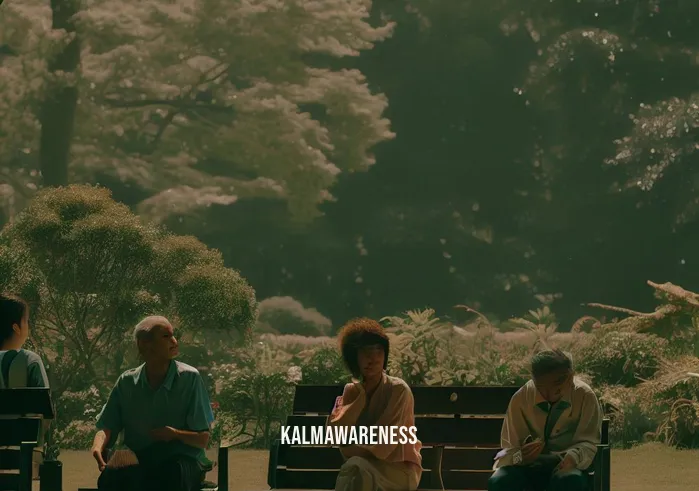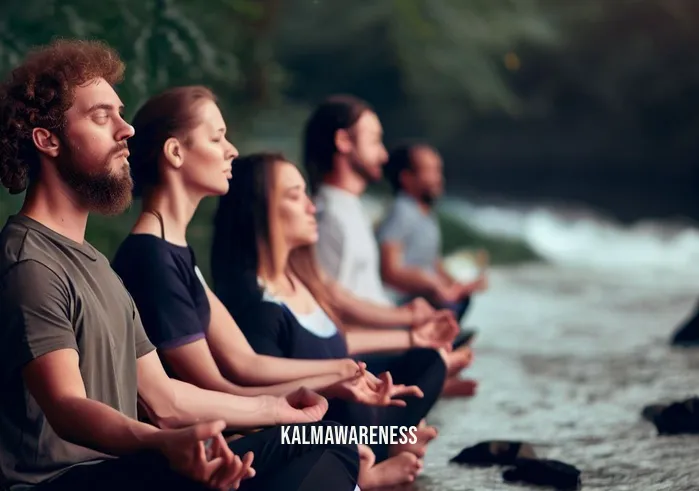Exteroceptive Meditation Examples: Awakening The Senses
Meditation has long been seen as a tool for introspection and self-awareness, diving deep into one’s internal world. However, exteroceptive meditation challenges this traditional perspective, shifting focus from inward to outward. As the name suggests, exteroceptive meditation examples center on perceiving and responding to external stimuli, primarily through our senses.
Understanding Exteroception
Exteroception, at its core, pertains to our ability to perceive external stimuli through our senses. It emphasizes how our body interacts with and understands the world around it. It’s the rustling of leaves, the gentle touch of a breeze, or the distant hum of traffic that we consciously notice and connect with.
This kind of awareness taps into our body’s natural mind-body connection. It’s a harmony where our senses, perception, and cognition seamlessly intertwine, crafting a holistic experience of our surroundings.
The Art of Engaging the Senses
Harnessing the power of exteroceptive meditation requires an understanding of how deeply our senses are interwoven with our experiences. The anxiety of the senses trick us at times, but when we are mindful, we can navigate through the distortions and genuinely appreciate what each sense brings to the table.
Sight: Vision often dominates our perception. When meditating, observe the colors, shapes, and movements around you. Articles like “Looking in the mirror and seeing someone else” and “What do you see, you people gazing at me?” delve into the profound implications of vision on self-awareness.
Hearing: Embrace the soundscape. Whether it’s nature’s whispers or urban rhythms, listening mindfully can ground us. It is an art of acknowledging the noises without getting lost in them.
Touch: Feel the world. Be it the texture of a fabric or the coolness of water, touch connects us to the tangible realities of our environment.
Taste and Smell: These senses are often overlooked but can be potent triggers for memories and emotions. Being present when savoring a meal or noticing a fragrance can make mundane moments extraordinary.
External Stimuli and Body Awareness
Our bodies are constantly in communication with the external environment. Each touch, sound, or sight evokes a unique physical response. This intricate dance between the body and its surroundings is an integral part of Body awareness.
When we start to meditate with an exteroceptive approach, we begin to notice these subtle reactions. The goosebumps from a chilly wind or the relaxation felt under warm sunlight are simple examples. As we become more attuned, our body becomes a vessel of awareness, channeling the healing force of our surroundings.
Breathing as the Anchor
One might wonder, amidst the overwhelming stimuli, how do we stay grounded? The answer lies in our breath. The rhythmic inhale and exhale serves as an anchor, connecting our internal and external worlds. Whole body breathing offers a comprehensive guide on how breath can be a conduit for enhanced exteroceptive meditation. Notable figures like Bruce Lee, explored the depths of this connection through meditation practices that harmonized breath, body, and the external environment.
Conclusion
As we embark on this journey through exteroceptive meditation examples, we’ll delve deeper into the techniques, benefits, and nuances that make this practice transformative. By embracing the richness of our senses and harmonizing with our surroundings, we open doors to a more profound awareness and connection. The foundations laid in this segment will pave the way for more intricate discussions on exteroceptive practices, ensuring a holistic understanding.
To truly grasp the essence and potential of this meditative practice, continue reading to further unravel the depth and nuances of exteroceptive meditation in the next segment.

Exteroceptive Meditation Techniques: A Deeper Dive
As we continue our exploration into exteroceptive meditation, it becomes evident that this form of mindfulness offers a diverse array of techniques. By focusing on external stimuli and body reactions, practitioners can cultivate an enriched understanding of their surroundings and their place within it. This chapter will delve into specific exteroceptive meditation examples, emphasizing their significance and benefits.
Embracing Exteroceptive Meditation: Why It Matters
The concept of exteroceptive meditation is not new, but its prominence in modern mindfulness practices is gaining momentum. One reason for this is the increasing recognition of the benefits of connecting with the external world. Engaging with our surroundings allows us to:
- Develop a deeper sense of presence in the moment.
- Enhance our sensory perception, ensuring we experience the world more vividly.
- Build resilience by learning to navigate and adapt to constantly changing external factors.
There’s a popular saying, “My thoughts are not your thoughts”, which underscores the importance of recognizing the unique way each of us interacts with the world. By understanding and valuing our unique sensory experiences, we can cultivate richer relationships with our environment and the people in it.
Key Techniques in Exteroceptive Meditation
As we navigate the myriad of exteroceptive meditation examples, it’s essential to recognize the common techniques that practitioners employ. These include:
Nature Immersion: Spending time in nature, absorbing the sights, sounds, and sensations. This can be a walk in the park, a hike, or just sitting by a stream.
Dynamic Listening: Actively tuning into sounds around you without judgment. This practice can be particularly beneficial in urban environments, where the sonic landscape is complex.
Tactile Exploration: Engaging with various textures and temperatures, consciously observing your body’s reactions.
Each technique has its merits, and the key lies in exploring them to find what resonates best with an individual’s preferences and needs.
Comparing Exteroceptive Meditation Techniques
| Technique | Primary Sense Engaged | Benefits | Ideal Setting |
|---|---|---|---|
| Nature Immersion | Sight & Hearing | Promotes relaxation, reduces stress, enhances appreciation for nature. | Parks, forests, beaches. |
| Dynamic Listening | Hearing | Improves focus, heightens auditory senses, nurtures patience. | Urban environments, nature spots. |
| Tactile Exploration | Touch | Develops tactile sensitivity, fosters mindfulness, connects with surroundings. | Varied, tactile-rich environments. |
While the table provides a concise overview of the various techniques, diving deeper into resources such as “The mind and the brain: Neuroplasticity and the power of mental force” can offer more profound insights into how these practices can alter our brain’s structure and function.
The Interplay of Brain, Heart, and Environment
The beauty of exteroceptive meditation lies in the seamless interaction between our internal systems and the external world. Resources like “Brain and heart coherence by Joe Dispenza” shed light on the intricate dance between our cognitive and emotional systems and how they can be harmonized for holistic well-being.
Moving Forward
While we’ve delved deeper into exteroceptive meditation examples in this chapter, our exploration is far from over. The world of external awareness is vast, filled with unique practices, techniques, and experiences waiting to be uncovered.
In the next segment, we’ll journey further, exploring advanced techniques and understanding the transformative potential of exteroceptive meditation. So, continue reading to discover more layers and dimensions of this profound practice.

Exteroceptive Meditation: Sources of Hope and Inspiration
As we dive further into the world of exteroceptive meditation, it’s apparent that this practice isn’t merely about sensory awareness—it’s a portal to profound hope, growth, and inspiration. Many individuals have harnessed the power of exteroceptive mindfulness, drawing motivation from their surroundings and translating it into transformative life experiences.
Tales of Transformation Through Sensory Awareness
One such example is the story covered in “I will ease your pain“. Here, a woman grappling with the aftermath of a traumatic experience found solace in the rhythmic sounds of waves crashing onto a beach. For her, this external stimulus became a metaphor for life—challenges come in waves, sometimes calm, sometimes furious, but always in motion.
Another inspirational journey is highlighted in “I’m where yesterday follows today and tomorrow is in the middle“. The protagonist explores the realm of sensory meditation, leveraging sounds and tactile sensations to journey through time in his mind, reconciling with past traumas and envisioning a hopeful future.
Such examples underscore the transformative potential of exteroceptive mindfulness, painting a picture of hope for those willing to embrace and practice it.
Quotable Insights on Hope and Meditation
When it comes to hope and meditation, many luminaries have voiced their perspectives. Here are some quotes that beautifully capture the essence of exteroceptive meditation:
- “In the gentle hum of nature, we find the melodies of hope.” – Anonymous
- “By tuning into the world, we tune into ourselves. Every sound, every touch is a whisper of inspiration.” – Unknown
- “Sensory meditation is not just feeling the world but letting the world feel you, touch your soul, and kindle hope within.” – Unknown
- “In the simplest of sensations, the most profound of truths can be discovered.” – Anonymous
- “Hope isn’t a place or a time. It’s a feeling, often awakened by the world around us.” – Unknown
The Warrior’s Journey with Sensory Mindfulness
Drawing from the article “Warrior Brain“, we encounter the tale of a soldier returning from combat. The chaos of war left him disoriented in the newfound silence of civilian life. Through exteroceptive meditation—by feeling the grass under his feet, listening to the wind rustle through trees, and observing the dance of fireflies—he rediscovered his inner peace. The external stimuli provided a channel to process the traumas of war, bringing clarity, peace, and hope.
The Spiritual Resonance
Exteroceptive meditation transcends the physical. The article “3D to 5D consciousness by Nyla” sheds light on how sensory experiences can be gateways to higher dimensions of consciousness. By genuinely feeling and perceiving the world, we can tap into spiritual realms, drawing inspiration from cosmic energies and forces.
Looking Ahead
While this chapter touched upon the hope and inspiration derived from exteroceptive meditation, it is only a fragment of the complete tapestry. The journey of external awareness is vast, filled with uncharted territories waiting to be explored.
In our next segment, we’ll delve into the science behind exteroceptive mindfulness, revealing the fascinating interplay of brain, body, and environment. Join us as we continue our exploration, venturing deeper into the intricacies of exteroceptive meditation.

Unraveling Exteroceptive Meditation: A Comprehensive Breakdown
Exteroceptive meditation, by design, draws upon the myriad of external stimuli and sensations that surround us. By immersing oneself in the external environment, practitioners can cultivate a deeper, more meaningful connection with the world. But how does one begin? What are the core principles, techniques, and considerations when practicing this form of mindfulness? Let’s break it down for a clearer understanding.
Key Principles of Exteroceptive Meditation
Presence: Being wholly present is paramount. It’s about immersing oneself in the ‘now’ and truly experiencing every stimulus.
Non-Judgment: Observing without evaluating or categorizing ensures a pure, unfiltered experience.
Curiosity: Approach each meditation session with the wonder of a child, eager to discover and learn.
Acceptance: Embrace each sensation, whether pleasant or unpleasant, without resistance.
Flexibility: Recognize that every session will be different, influenced by varying external factors.
Techniques and Their Respective Focuses
Sensory Walks: Emphasizes on movement and observation.
- Engage all senses as you walk.
- Notice textures underfoot, sounds of nature, or urban life, and the play of light and shadows.
- Regularly practiced in natural settings but can be adapted for urban environments.
Guided External Awareness:
- Often facilitated by a guide or a recorded voice.
- Directs your attention to various external stimuli.
- Can be practiced in groups or individually.
Mindful Eating:
- Focuses on taste, texture, and smell.
- Cultivates gratitude for the food and the processes that brought it to your plate.
- An excellent practice for improving digestion and fostering a healthier relationship with food.
Common Challenges and Overcoming Them
Overwhelm: With numerous stimuli, it’s common to feel overwhelmed.
- Solution: Start with short sessions, focusing on one sense at a time. Gradually expand as you become more comfortable.
Distraction: Our minds are often busy, making it challenging to focus.
- Solution: Gently acknowledge the distraction and redirect your attention. Regular practice will enhance focus.
Expectation: Aiming for a specific experience or outcome can hinder the process.
- Solution: Approach each session without any predefined expectations. Let the experience unfold naturally.
Real-Life Inspirations
Drawing from the piece on “Spiritual meaning of lower back pain”, we can see how external stimuli, like posture and environment, influence our internal experiences. Another insightful read is “Mirror Fact”, which emphasizes the importance of reflection, not just in the physical sense but also in how we perceive the world and our place in it.
How Exteroceptive Meditation Fits Into Broader Mindfulness Practices
While exteroceptive meditation shines a spotlight on external stimuli:
- Interoceptive Meditation centers on internal bodily sensations.
- Meta-cognitive Meditation focuses on our thoughts and emotions.
- All these practices, though distinct, are interconnected. One can flow seamlessly into the other, offering a holistic mindfulness experience.
To the Journey’s End and Beyond
As we’ve navigated the depths of exteroceptive meditation in this chapter, we’re now poised to conclude our exploration. However, every ending is a new beginning. In our final chapter, we’ll synthesize everything we’ve learned, offering a roadmap for integrating exteroceptive meditation into daily life. Prepare for a culmination of insights and actionable steps in the next segment.

Exteroceptive Meditation: Reflecting on the Journey
As we draw our explorative journey on exteroceptive meditation examples to a close, it’s essential to pause, reflect, and appreciate the myriad of insights and perspectives we’ve gathered. This voyage has not just been about understanding a meditation technique; it’s been about realizing the profound connections between us and the external world.
The Essence of Exteroceptive Mindfulness
At its core, exteroceptive meditation encourages us to be present, to genuinely experience the world in all its vividness and variety. Whether it’s the delicate caress of a breeze, the cacophony of a bustling city, or the mesmerizing hues of a sunset, these practices remind us of the simple joys around us. As highlighted in the thought-provoking piece “Why do I have bad luck with guys?“, it’s evident that our external experiences deeply influence our perceptions, choices, and overall well-being.
Key Takeaways from Our Journey
Diversity of Techniques: From sensory walks to tactile explorations, the range of exteroceptive meditation techniques is vast, offering something for everyone.
Holistic Well-being: By connecting with our environment, we foster mental, emotional, and spiritual growth, enriching our overall life experience.
A Portal to Hope: As we’ve seen, exteroceptive meditation can be a source of inspiration, offering solace, clarity, and hope in challenging times.
Applying the Insights
Armed with the knowledge and understanding of exteroceptive mindfulness:
- Dedicate a few minutes daily to practice, starting with short sessions and gradually expanding.
- Explore different environments—nature, urban settings, home, or work—and observe how each offers unique stimuli.
- Document your experiences in a journal, capturing the sensations, emotions, and reflections from each session.
Your Next Steps
The world of mindfulness is vast and diverse, and while we’ve dived deep into exteroceptive meditation, there’s so much more to explore. For those curious about the interplay of mind, body, and surroundings, the article on “What does ‘Brain like Berkeley’ mean?” offers a fascinating read.
If you’ve found value in our journey together, consider revisiting previous chapters or exploring other insightful articles on our platform. Every piece is crafted with care, aiming to enlighten, inspire, and guide.
A Heartfelt Thank You
To each reader who’s embarked on this journey with us, thank you. Your curiosity, engagement, and willingness to explore have made this exploration meaningful. As we conclude this chapter, remember that every end is a new beginning. Stay tuned for more insightful content in our upcoming editions, and always, keep exploring, keep growing.
Until next time, cherish the world around you, find joy in the simple things, and let exteroceptive meditation be your guiding light.



